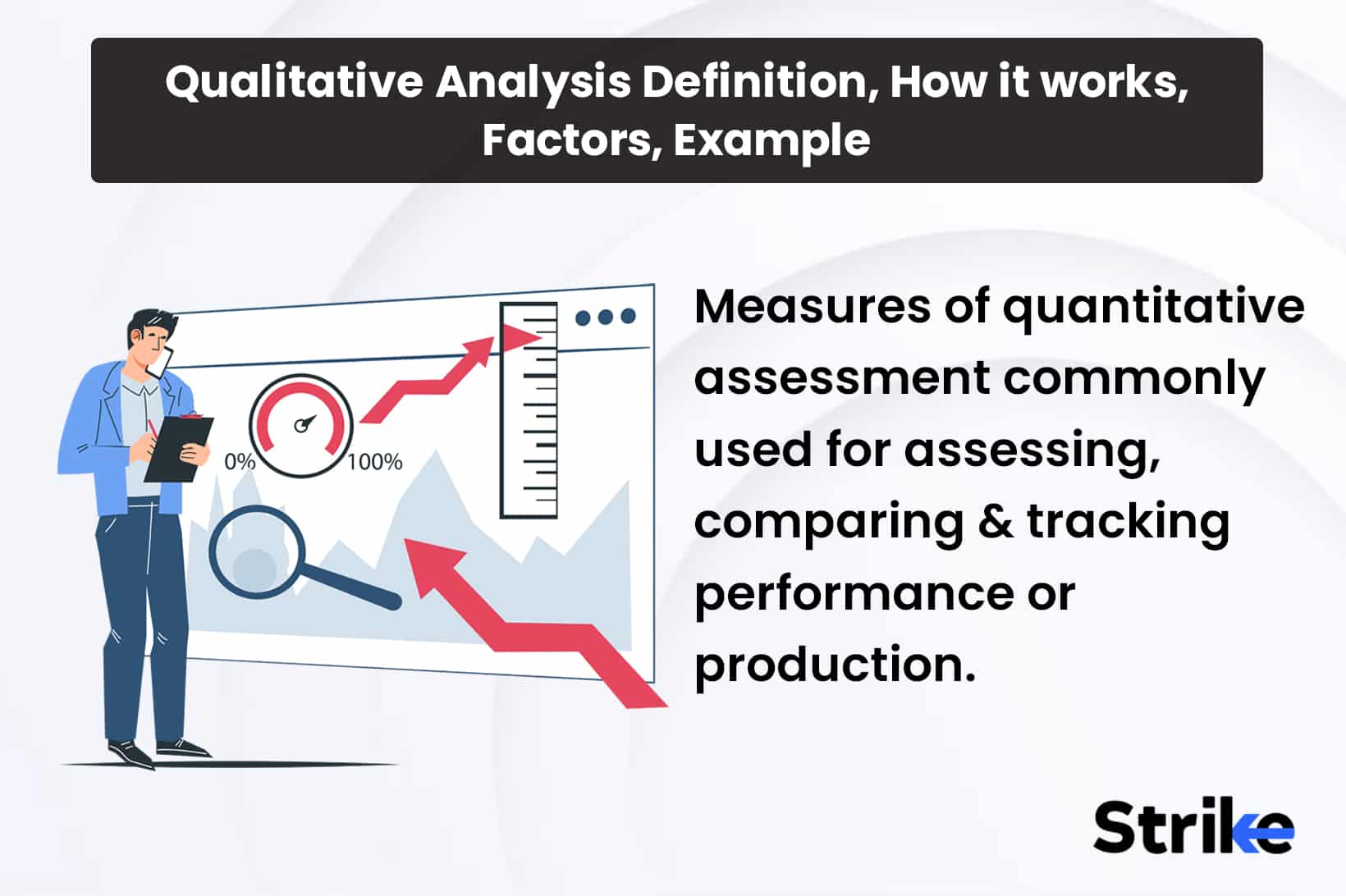
Qualitative analysis is an important part of evaluating stocks and making investment decisions. Qualitative analysis involves analyzing non-numerical and subjective factors that can impact a company’s performance and stock price. An investor would gather qualitative data on aspects like management quality, business strategy, competitive advantage, industry growth trends, research and development, etc. This data can come from sources like management interviews, company reports, industry analysis, news articles, etc. Strong, experienced leadership is a positive qualitative factor. They may also evaluate the effectiveness of a company’s business strategy, marketing approach, or R&D investments in maintaining a competitive edge.
The quality of the products, services, and brands offered by the company also matters. Customer satisfaction levels, brand reputation, and company culture are important qualitative factors. Assessing the growth potential and trends in the Industry in which the company operates is also key. All this qualitative data is used to supplement quantitative metrics and make a holistic evaluation of the company’s overall prospects and potential as a stock investment. The subjective interpretation of qualitative factors, along with quantitative analysis, provides a more complete picture.
What is qualitative analysis?
Qualitative analysis refers to the analysis of qualitative factors or non-numerical information to evaluate a company’s financial health, business model, management, and competitive advantages for making investment decisions in the stock market. Qualitative analysis depends on subjective judgment based on non-quantifiable information. Qualitative analysis consists of examining various qualitative factors that impact a stock’s performance. Six key qualitative factors analyzed in qualitative analysis for stock selection are industry analysis, business model analysis, management quality, competitive advantages, financial strength, ESG analysis, and macroeconomic analysis.
Investors look at the Industry the company is in. They want to invest in growing, stable industries with low risks. For example, technology has been an attractive industry to invest in due to innovation and demand. Investors also look at the company’s business model and products/services. They want companies with unique offerings that competitors can’t easily copy. For example, Amazon’s e-commerce model makes it appealing.
The experience and leadership of the company’s management team is reviewed. Stocks of companies with strong management tend to perform better. For example, Berkshire Hathaway has done well under Warren Buffett. A company’s competitive position is assessed based on factors like brand, distribution network, patents, and cost structure. Companies with durable competitive advantages can better withstand competition. For example, luxury brands like LVMH have pricing power due to brand value.
The company’s financial health is analyzed by looking at metrics like debt, cash flow, and return on capital. Companies in strong financial shape have lower risks. For example, Apple and Microsoft’s robust cash flows make them appealing. Broader economic factors like recessions and policy changes are considered for their potential impact on the company. For example, airline stocks tend to suffer in recessions as travel drops.
Environmental, social, and governance (ESG) factors are increasingly analyzed. Companies with better ESG standards and practices tend to have lower risks and more sustainable growth. For example, companies violating labor laws or involved in scandals suffer reputational damage. Qualitative analysis is often supplemented by quantitative analysis, like ratio analysis, for a comprehensive evaluation. However, qualitative factors often drive a company’s intrinsic value in the long run. For example, though difficult to quantify, a disruptive new technology fundamentally impacts an industry’s structure.
How does qualitative analysis work?
Qualitative analysis works by examining non-numerical factors that can impact a stock’s performance. The goal is to gain insights into a company’s fundamentals, growth potential, and intangible strengths or weaknesses that affect its value and investment prospects.
Qualitative analysis employs methods like management interviews, facility tours, conversations with employees, vendors, and customers, and reviewing industry data, corporate documents, and trade publications. This provides a nuanced perspective on the company’s operations, workplace environment, and strategic direction. The analyst combines these observations with their own judgment, experience, and Industry knowledge to identify the most promising companies.
For example, a company with new innovative products, visionary and ethical leadership, satisfied employees, lean operations, and markets poised for expansion would get a highly favorable qualitative assessment. The qualitative insights complement quantitative metrics, balancing “hard numbers” with “soft factors” to evaluate investment potential.
Qualitative analysis provides crucial context around the numbers and intangible qualities not quantifiable through financial modeling. It incorporates human judgment and discernment to go beyond spreadsheets. The blend of quantitative and qualitative research provides a comprehensive framework for wiser investment decisions and stock analysis.
What are qualitative factors in fundamental analysis?
Four key qualitative factors considered in the fundamental analysis are management quality, Corporate Governance, Business model, and Industry competition in fundamental analysis.
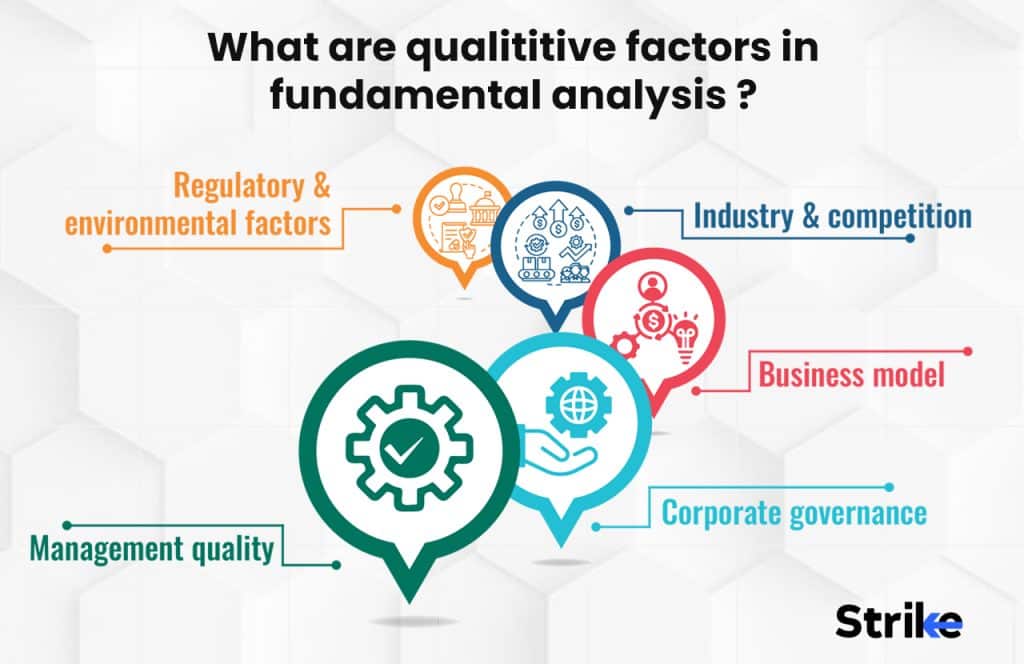
1.Management quality
Management quality is a critical qualitative factor to analyze in fundamental analysis when evaluating a company for stock investments. The skills, experience, vision, and ethics of management play a pivotal role in driving a company’s performance and shareholder value creation. Stocks of well-managed companies tend to outperform the broader market over the long run.
The background and work experience of the top management team provides insights into their capabilities. Education qualifications in relevant fields, years of industry experience, career highlights, and achievements are reviewed. Managers who have previously worked at leading companies demonstrate strong operational knowledge. Domain expertise and extensive experience enable effective leadership.
The leadership style and abilities of managers are critical. Effective leaders galvanize employees towards a vision, think strategically, and foster a performance-driven work culture. They act decisively under pressure and align teams to achieve goals. Poor leadership demotivates employees, creates discontent, and hurts productivity. Analysts assess leadership skills by observing manager’s communication clarity, transparency with stakeholders, and track record in driving organic growth. For example, renowned leaders like Steve Jobs demonstrate exceptional vision and leadership abilities.
2. Corporate governance
Corporate governance refers to the system of policies, processes, and people that direct and control a company. Strong corporate governance ensures transparency, accountability, and ethical business practices that protect shareholder interests. Evaluating governance standards is an important part of qualitative analysis in stock investing. Companies with robust governance have lower risks and tend to deliver superior long-term returns. The composition and functioning of the company’s board of directors provide insights into governance standards.
The presence of independent directors, separation of Chairman and CEO roles, diversity, director qualifications, and overall independence of the board are assessed. Boards with a majority of independent directors provide effective oversight and prevent promoter conflicts. Regular board evaluations, limited tenures, and mandatory retirements improve quality. Infrequent board meetings, directors serving on multiple boards, and interlocking directorships signal weak governance.
3. Business model
A company’s business model refers to its system for creating, delivering, and capturing value. Analyzing the sustainability, competitiveness, and adaptability of a business model is a key part of qualitative analysis in stock research. Business model risks outweigh financial risks in their impact on a company’s long-term prospects. The company’s portfolio of products and services that generate revenue are reviewed.
Factors like product differentiation, competitive advantages, customer utility, recurring revenues, synergy across offerings, etc., provide insights. A robust product portfolio caters to diverse customer needs and supports multiple revenue streams. The target customer segments, buying power, and retention rates reveal growth opportunities. The size, demographics, and needs of key customer groups are analyzed. Companies catering to growing segments and under-served needs often sustain higher growth.
4. Industry & competition
The industry environment and competitive landscape in which a company operates critically impact its performance. Assessing industry structure, growth prospects, competitive intensity, and dynamics is a key qualitative analysis in stock research. Attractive industries with conducive structures enable companies to sustain high profitability. The overall industry growth trajectory based on past trends and future projections is analyzed.
Both near-term growth and long-term outlook in industry analysis are reviewed. Rapidly growing industries like technology provide tailwinds, while declining industries like coal face headwinds in industry analysis. Higher industry growth potential signals strong investment prospects. The number of players, concentration levels, switching costs, ease of new Entry, and intensity of rivalry indicate industry competitiveness. Moderately competitive industries with 3-4 balanced players are most attractive. Highly fragmented or concentrated industries struggle to sustain profitability.
5. Regulatory and environmental factors
The regulatory landscape and environmental factors related to social, governance, and climate issues are important qualitative considerations in stock research. Regulations and environmental standards have a material impact on companies across sectors. Proactively analyzing these external factors is key for balanced investment decision-making. The key regulations governing a company’s Industry are reviewed to assess associated risks, constraints, and opportunities.
Regulatory analysis involves identifying governing bodies, compliance requirements, upcoming regulatory changes, geographic variations, and any legal risks. This helps evaluate the impact on companies in terms of costs, restrictions, and risks. Firms adapt strategies to regulations, while investors avoid stocks with high regulatory risks or find potential winners and losers from new regulations. Proactively assessing regulations provides insights into sector dynamics for both companies and investors.
What is qualitative data of a stock?
Qualitative is non-numeric information that provides insights into a company’s business operations, industry dynamics, management capability, competitive positioning, macroeconomic environment, and other fundamental characteristics. Analyzing qualitative data is a critical component of equity research and stock analysis. Important company information sources include annual reports providing a business overview, management discussion, risks, opportunities, and corporate governance details.
Earnings calls give remarks by management on financial results, strategy, industry trends, and competitive landscape. Investor presentations offer details on new products/services, market expansion plans, R&D updates, partnerships, and other strategic initiatives. Finally, press releases make announcements regarding the latest developments, regulatory changes, and other important updates.
How to find the qualitative data of a company?
Begin by looking at the company’s investor relations website, annual reports, and SEC filings. Many companies provide business overviews, company culture information, executive profiles, and business strategies in shareholder letters and management discussions. For example, annual reports often showcase products, facilities, technologies, and employee stories that give qualitative insights. Read with an investigative eye to get the company’s perspective.
Search for recent news, industry trade publications, and specialized business journals relevant to the company and its sectors. Look for interviews with company management and employees, new product announcements, culture profiles, executive changes, lawsuits, expansion plans, partnership deals, and operational developments. Third-party news gives more objective glimpses than the company’s own communications.
Seeking expert analysis and review of equity research reports from Wall Street analysts, rating agencies, and investment advisors. Check footnotes for clues on their qualitative data sources, like facility visits, calls with management, and channel partner conversations.
What Are the Methods of Qualitative Analysis?
The qualitative analysis encompasses various frameworks to evaluate a company’s position and prospects, including Porter’s Five Forces, which analyses the competitive landscape; BCG Matrix, which categorizes business units based on market share and growth; SCP Model, examining how market structure impacts conduct and performance; SWOT identifying strengths, weaknesses, opportunities and threats, and PEST analyzing the external political, economic, social and technological factors affecting an organization.
1. Michael Porter’s Five Force Model
Developed by renowned business strategist Michael Porter, the Five Forces model provides a framework for qualitative competitive analysis. It assesses the balance of power across the competitive landscape that shapes a company’s profitability outlook. Using this approach to your stock analysis provides insightful information on how industry dynamics affect investing opportunities. The five forces are Competitive Rivalry, Supplier Bargaining Power, Buyer Bargaining Power, Threat of Substitutes, and Threat of New Entrants.
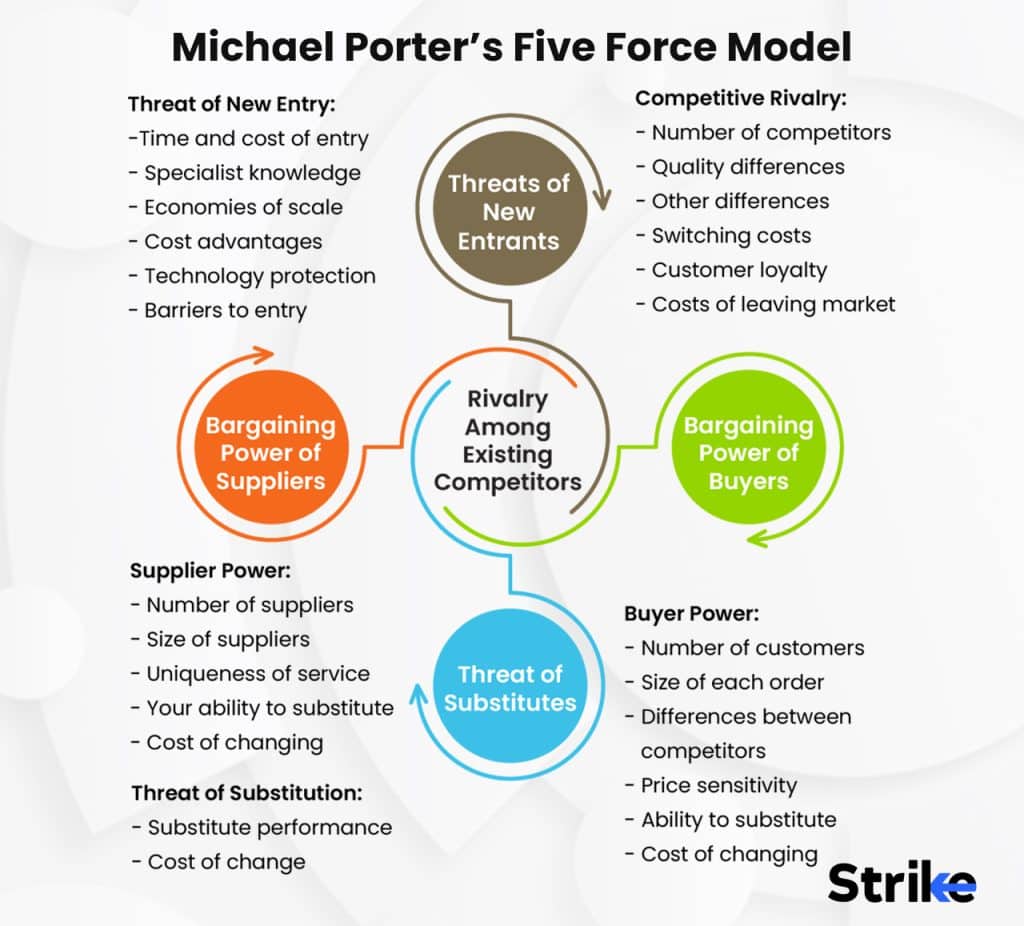
Competitive Rivalry force examines how intense competition is among existing companies in the Industry. A highly fragmented market signals an opportunity for consolidation and economies of scale. At the same time, a concentrated oligopoly suggests that incumbent players hold pricing power and competitive advantages. Monitoring rivalry requires gathering qualitative data on competitors’ strategies, capabilities, and execution through management interviews, industry conferences, and media reports.
Supplier Bargaining Power analyses how much leverage a company’s suppliers have in negotiations. Suppliers holding power sometimes raise prices, reduce quality, or take away volume, negatively impacting profitability. Researching supplier dynamics involves supply chain checks, like speaking with vendors, monitoring procurement contracts, and evaluating substitution options.
Qualitative data reveals dependency risks. Buyer Bargaining Power force evaluates how much influence customers have in extracting price and service concessions from companies in the Industry. Powerful customers reduce margins. Investors sometimes conduct focus groups, survey target demographics, and interview distributors to assess customer loyalty versus price sensitivity qualitative factors like switching costs and brand equity.
The threat of Substitutes examines the risk that new product alternatives could win business away from incumbents by offering superior prices or performance. Monitoring patent filings, emerging technologies, consumer surveys, and speaking with industry researchers provides qualitative signals on disruptive threats and product obsolescence risks.
The Threat of New Entrants force considers how easy or difficult it is for new competitors to enter the Industry. Significant barriers like high capital costs, branding, economies of scale, regulatory burdens, and patents help entrenched companies block disruptors. However, low barriers increase competitive threats. Trade publications, industry analyst reports, and management interviews provide color on competitive dynamics.
2. Boston Consulting Group Analysis
The growth-share matrix developed by the Boston Consulting Group (BCG) provides a framework for qualitative competitive analysis of a company’s business units or product portfolio. By categorizing subsidiaries based on growth rates and market share, the BCG matrix facilitates strategic analysis useful for stock research. The BCG matrix divides businesses into four categories: Stars, Cash cows, question marks, and dogs.
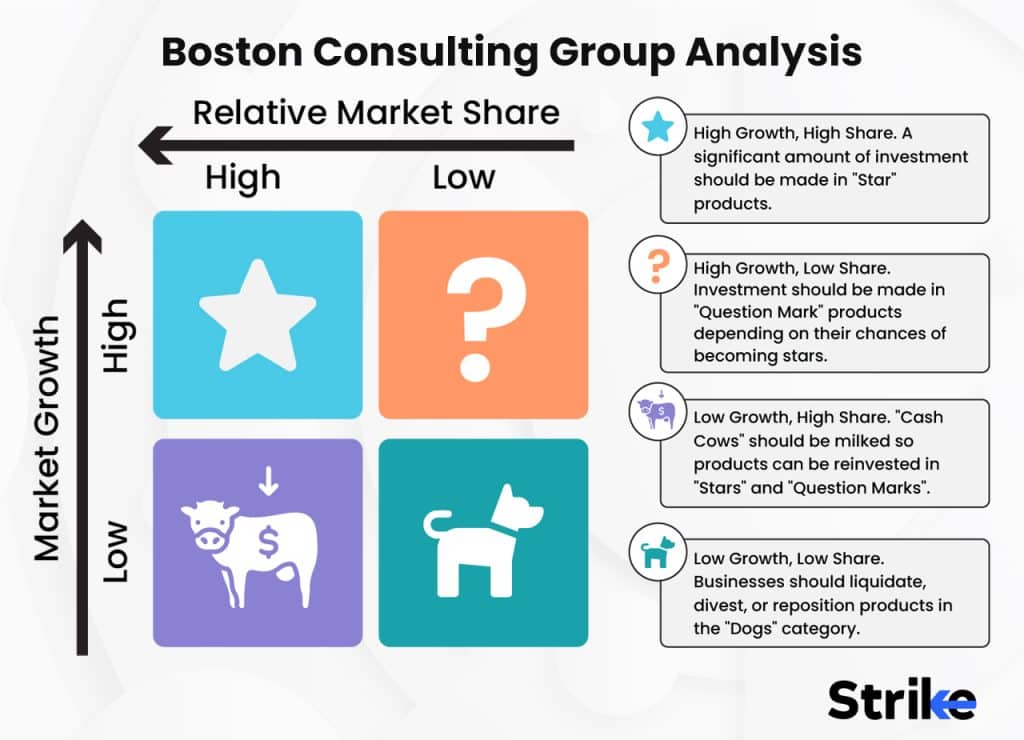
Stars are units with high market share in fast-growing markets. Stars require heavy investment to sustain expansion but promise high future returns. Investors should gather qualitative data on star potential through management interviews, industry conferences, and demographic research.
Cash Cows is an established business with a high market share in slow-growing markets. Cash cows require little investment but generate sizable cash flows. Talking to customers, touring facilities, and analyzing relationships reveal qualitative signs of cash cow durability. Question Marks are units with low market share in higher growth markets. They show promise but require substantial investment to grow share. Market research, product testing, and competitive analysis provide qualitative input on question mark potential.
Dogs are businesses with low shares in slow-growth markets. Dogs generate weak returns on investment. Strategic analysis and management interviews identify dogs to potentially divest. Investors use the BCG matrix to determine the strategic and financial contributions of different business units or product lines while conducting due diligence on a firm. The Boston Consulting Group matrix provides a qualitative framework to assess a company’s business units and product lines across growth opportunities, profit drivers, resource allocation needs, M&A strategy, potential synergies, and vulnerabilities.
Analyzing the business units categorized as stars, cash cows, question marks, and dogs facilitates evaluations of where to invest aggressively, where earnings are generated, how to smartly allocate capital, where M&A is needed to fill portfolio gaps, how shared capabilities across units offer synergistic advantages, and which smaller segments sometimes need to be divested or restructured. Supplementing the matrix with management interviews, conferences, site visits, org research, supply chain analysis, and monitoring quarterly changes provides further qualitative insights and color for strategy decisions.
3. Structure Conduct Performance Model
The Structure-Conduct-Performance (SCP) framework provides a model for qualitative industry analysis that is useful in stock research. The SCP model evaluates how industry structure affects corporate conduct and strategy, which then determines firm performance and profitability. Applying this analysis provides context for evaluating a company’s competitive positioning and earnings outlook based on its market environment. The model identifies three major structural variables that shape industry dynamics, including Concentration Ratios, Barriers to Entry, and Product Differentiation.
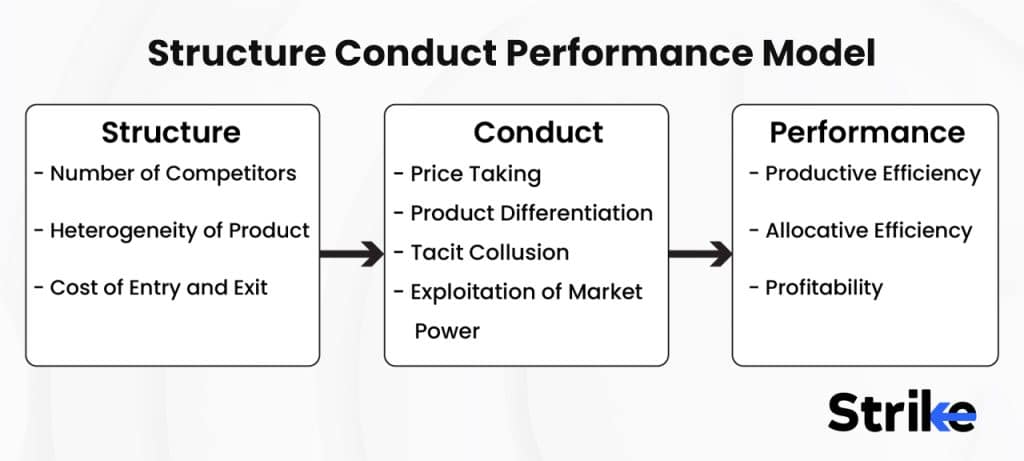
Concentration ratios are highly concentrated in a market dominated by a few large players, indicating greater pricing power and stability versus a fragmented industry. Monitoring consolidation trends, market share shifts, and competitive moves provide qualitative signals. Barriers to Entry are significant barriers like large capital costs, switching costs, economies of scale, branding, and regulations that help entrenched firms block disruptors. Low barriers increase competition. Management interviews and industry research provide color. Commoditized products with little differentiation lead to intense price-based competition. Unique offerings support premium pricing and loyalty. Surveys, customer interviews, and product analysis assess differentiation.
Commoditized markets see price-based rivalries. Concentrated oligopolies allow disciplined pricing between leaders. Product uniqueness supports premium pricing. Barriers to entry influence spending on R&D, marketing, and capacity. Open markets require efficiency gains to protect margins. Fragmented industries see consolidation roll-ups. Mature oligopolies limit large mergers, but tactical deals continue. Broad markets allow geographic and product expansion.
Niche sectors lead to specialization. The SCP model recognizes conduct established by industry structure ultimately impacts performance metrics. Pricing power from concentration yields higher margins. Commoditization diminishes returns. Diversification improves stability. Expanding, less mature sectors driven by differentiation achieve higher growth than established ones. Scale advantages in concentrated markets support capital efficiency. Fragmented markets diminish ROI.
4. SWOT Analysis
SWOT analysis is a useful framework for developing qualitative insights into a company by evaluating its strengths, weaknesses, opportunities, and threats. Investors gain a better knowledge of competitive positioning and business strategy by using SWOT analysis while examining equities. A company’s strengths are its key competitive advantages and core capabilities that allow it to create value.
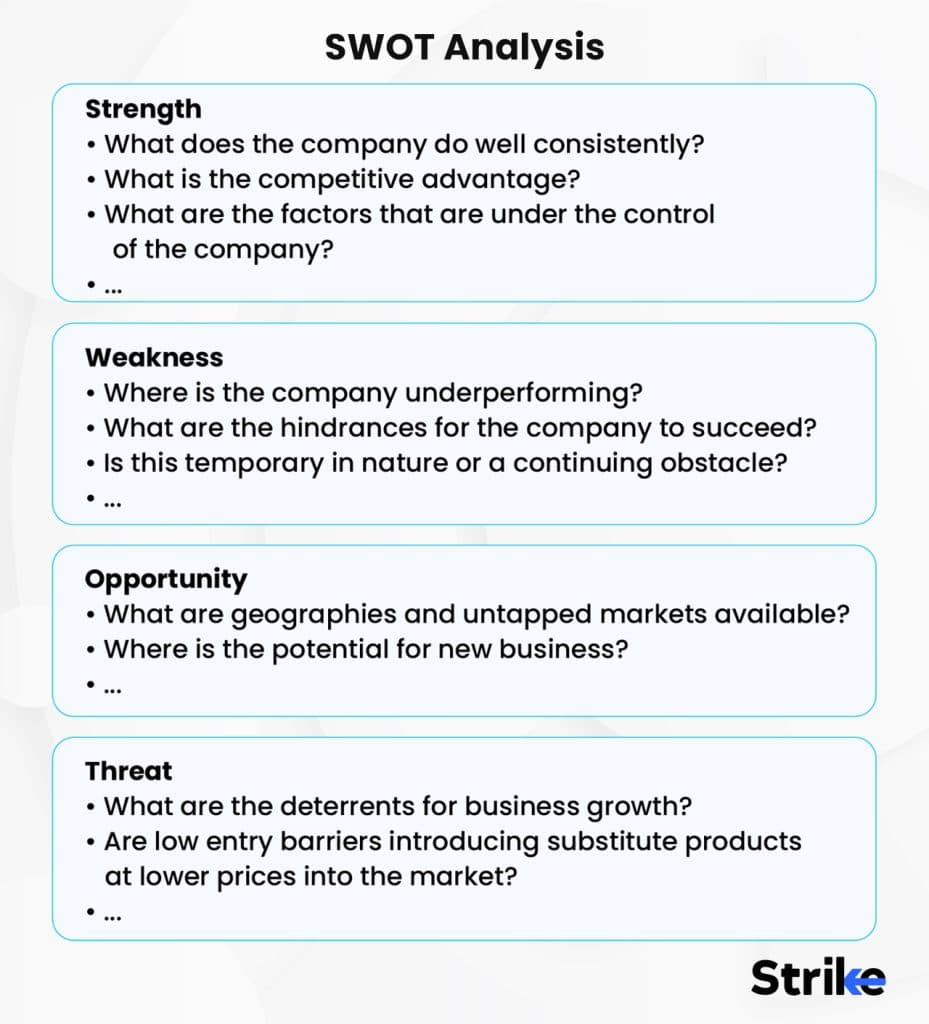
Investors identify strengths through methods like management meetings, factory tours, product demonstrations, and industry conference participation. The SWOT analysis framework identifies key strengths such as proprietary technology, strong brand reputation, talented leadership and workforce, unique distribution access, low costs, and operating efficiency, economies of scale, and network effects that provide competitive advantages.
The SWOT analysis highlights weaknesses such as higher costs, perception problems, geographic constraints, negative associations, dependence risks, and supply chain issues that present vulnerabilities, growth impediments, and areas needing remediation. Input from media, customers, employees, and management helps identify disadvantageous weaknesses.
The SWOT analysis identifies opportunities such as demographic shifts, new technologies, regulatory changes, competitor struggles, emerging channels, cultural trends, and affordable M&A targets that present potential growth avenues if capitalized early before rivals. Management vision articulated in interviews and presentations signals readiness to pursue detected opportunities.
The SWOT analysis highlights threats like competition, rival improvements, obsolescence risks, supply issues, regulatory burdens, downturns, and disruptive innovations that present external risks requiring contingency planning and strategic agility to manage. Engaging experts, researching competitors, and monitoring early signals helps identify emerging threats.
5. PEST Analysis
PEST analysis is a useful framework for developing qualitative insights into the external operating environment a company faces. It involves assessing the Political, Economic, Sociocultural, and Technological factors that impact a business. Doing stock research using PEST analysis gives useful background. Investors should monitor government regulations, trade policies, incentives, taxes, stability, and corporate lobbying to gauge the political landscape and anticipate impacts on industries and companies. Political intelligence is gathered through legislation tracking, conferences, and trade organizations.
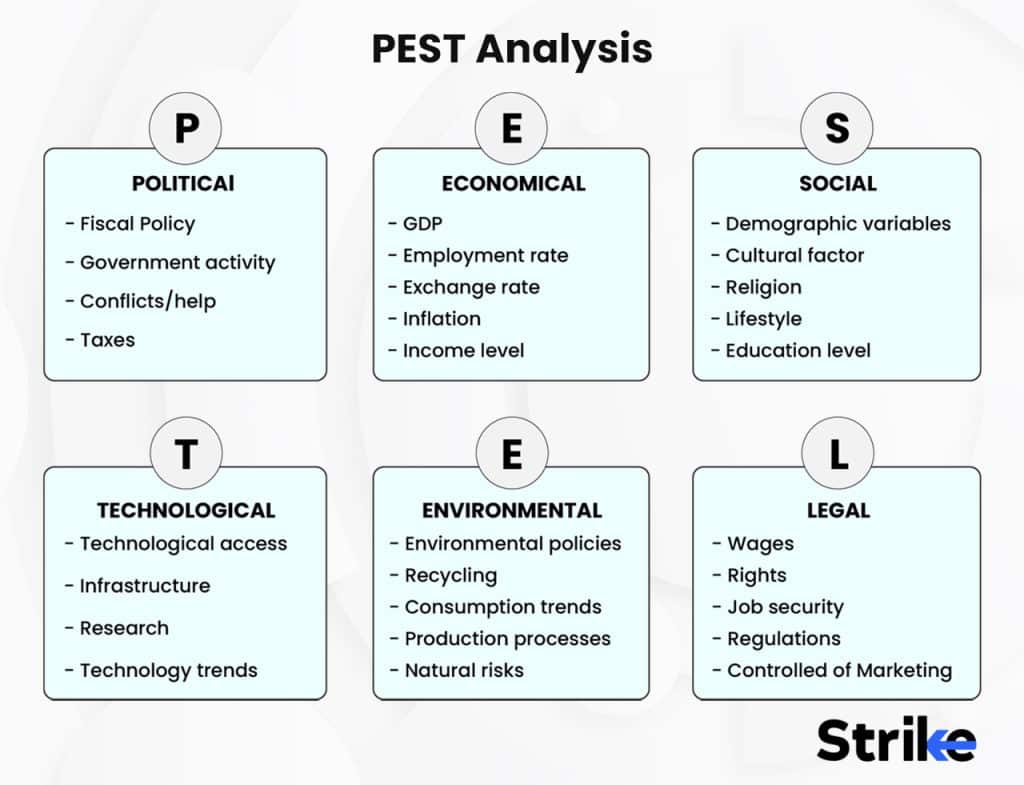
Investors should monitor GDP, jobs, consumer confidence, commodity prices, wages, interest rates, and currency movements to gauge market growth, demand cycles, costs, and capital availability. Economic data affects consumer and business behavior. Analytics, government reports, and management remarks provide context.
Investors should track demographics, urbanization, values, diversity, and preferences to identify evolving sociocultural trends. Monitoring population patterns, lifestyles, experiences, and multicultural influences helps adapt branding, products, and messaging to shifting consumer values and new customer cohorts. Surveys, focus groups, and media analysis spot cultural shifts.
Monitoring emerging technologies helps identify risks and opportunities in areas like substitutes, operational efficiency, cost curves, automation, innovations, and new distribution channels. Tracking substitute products, manufacturing methods, cost dynamics, AI, patent filings, and internet platforms provides intelligence on technological shifts disrupting business models, products, and activities.
Qualitative analysis complements quantitative research with non-numerical data gathered from management, customers, suppliers, partners, employees, industry contacts, media sources, and direct operational observations. Multiple techniques build a holistic context regarding a company’s competitive positioning, intangible assets, and growth opportunities.
What is an example of qualitative analysis?
An investor is looking to invest in an Indian auto company. They decided to conduct a qualitative analysis on two leading auto manufacturers – Company A and Company B. The investor first looked at the management team and board of directors of both companies. They find that Company A’s management has more experience in the auto industry compared to Company B’s board. Company A’s board also has directors with expertise in new technologies like electric vehicles, which will be crucial for future growth.
Next, they compare the brands of both companies. They know Company A has several iconic brands that enjoy high brand recall amongst Indian consumers. Company B’s portfolio also includes trusted SUV brands, but they are relatively newer than Company A’s established brands. The investor also evaluates the company’s vision and strategies. They find Company A is aggressively moving into electric vehicles, which aligns with India’s goal of rapid EV adoption.
Company B is also investing in EVs but is relatively slower. Company A also has set up advanced R&D centers focusing on new product development. Finally, the investor looks at sales and distribution networks. They see Company A has a countrywide sales presence through company showrooms and service centers. Company B also has a good network, but Company A’s appears more extensive.
Based on this qualitative analysis, the investor concludes Company A may be a better long-term investment bet compared to Company B due to its experienced leadership, strong brands, EV focus, and distribution strengths.
What are the main differences between qualitative vs. quantitative analysis?
Qualitative analysis involves assessing non-numerical factors like management and industry trends, while quantitative analysis focuses on numerical data like financial statements and valuation metrics to analyze stocks. Stock investors rely on both qualitative and quantitative analysis to evaluate investment opportunities. While they provide complementary insights, there are important philosophical differences between the two approaches.
Quantitative analysis deals with numerical, measurable data such as financial statements, valuation multiples, trading volumes, and financial ratios like P/E, ROI, profit margins, etc. It tries to understand a company through mathematical models and statistical techniques. Qualitative analysis deals with descriptive, non-numerical data from sources like news reports, management interviews, customer surveys, industry conferences, factory tours, product reviews, and competitive intel. It develops perspectives on intangible factors.
Quantitative techniques include financial statement analysis using ratios, discounted cash flow modeling, trading analysis of trends and patterns, and statistical regression modeling. The research aims to quantify relationships between variables and make forecasts. Qualitative methods involve gathering data from meetings, interviews, surveys, focus groups, ethnographic observation, and media monitoring. The aim is to develop narrative insights into business contexts from multiple perspectives.
The quantitative analysis ultimately produces numerical projections and recommendations, often expressed visually in tables, charts, and graphs. This communicates probabilities, confidences, and upside/downside capture scenarios. The qualitative analysis yields written narratives describing business dynamics, industry contexts, management capabilities, competitive forces, and cultural observations. The output is descriptive rather than statistical.








![85 Common Stock Market Terminologies for Dummies [Updated List for 2026] 70 85 Common Stock Market Terminologies for Dummies [Updated List for 2025]](https://www.strike.money/wp-content/uploads/2025/04/Popular-Stock-Market-Terms-for-Beginners-Banner.png)










No Comments Yet.